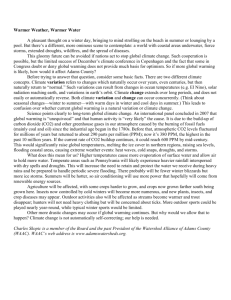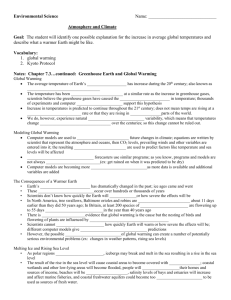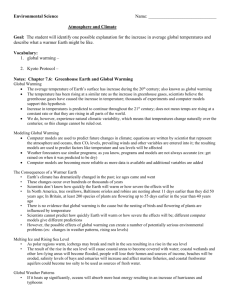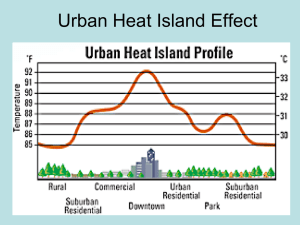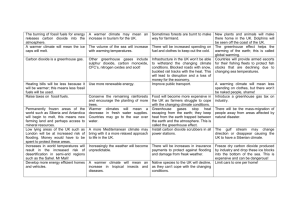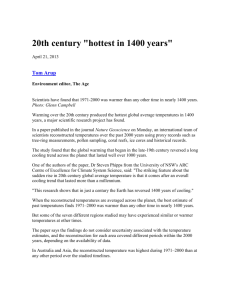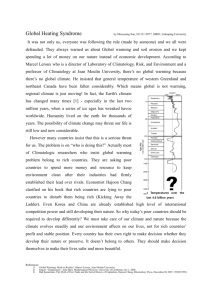a few notes on climate change and global warming
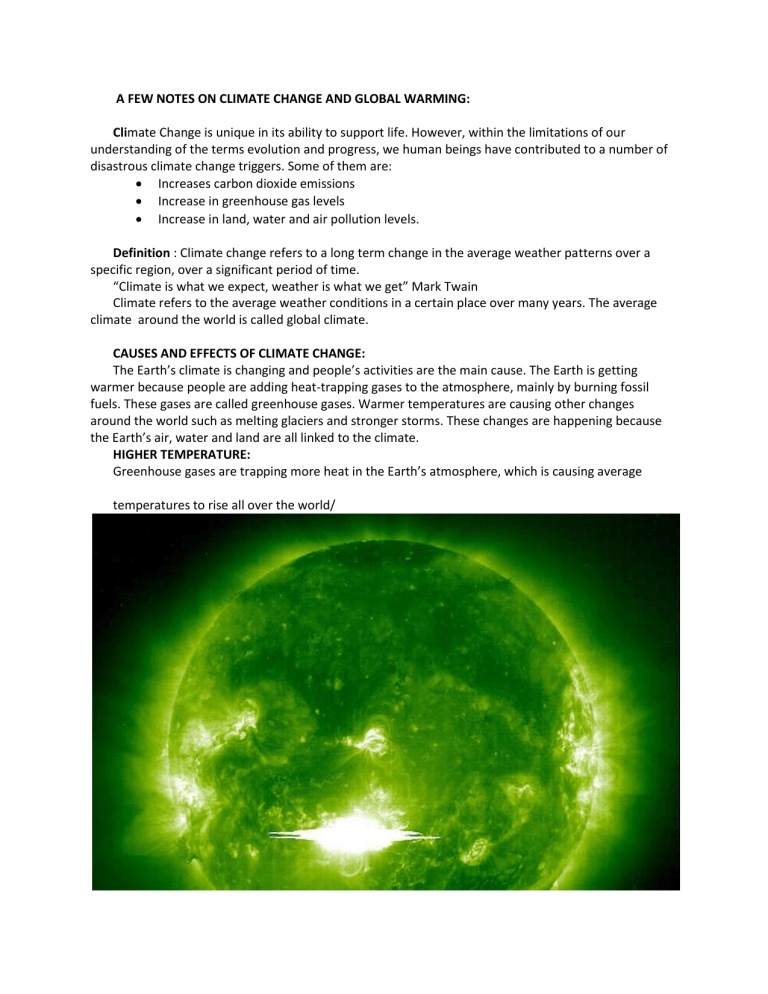
A FEW NOTES ON CLIMATE CHANGE AND GLOBAL WARMING:
Climate Change is unique in its ability to support life. However, within the limitations of our understanding of the terms evolution and progress, we human beings have contributed to a number of disastrous climate change triggers. Some of them are:
Increases carbon dioxide emissions
Increase in greenhouse gas levels
Increase in land, water and air pollution levels.
Definition : Climate change refers to a long term change in the average weather patterns over a specific region, over a significant period of time.
“Climate is what we expect, weather is what we get” Mark Twain
Climate refers to the average weather conditions in a certain place over many years. The average climate around the world is called global climate.
CAUSES AND EFFECTS OF CLIMATE CHANGE:
The Earth’s climate is changing and people’s activities are the main cause. The Earth is getting warmer because people are adding heat-trapping gases to the atmosphere, mainly by burning fossil fuels. These gases are called greenhouse gases. Warmer temperatures are causing other changes around the world such as melting glaciers and stronger storms. These changes are happening because the Earth’s air, water and land are all linked to the climate.
HIGHER TEMPERATURE:
Greenhouse gases are trapping more heat in the Earth’s atmosphere, which is causing average temperatures to rise all over the world/
Deforestation is also said to increase global warming. Trees contain a high level of carbon, and therefore their cutting creates an increase of carbon in the atmosphere.
The carbon dioxide problem is hard to fix, however, because it comes mainly from the burning of fossil fuels, which is so essential to modern life and commerce.
Carbon dioxide is not the only kind of pollution that contributes to global warming. Other warming agents include three short-lived gases-methane, some hydrofluorocarbons and lower atmospheric ozone and dark soot particles.
Higher temperature also causes the concentration of ozone in the lower atmosphere.
Ozone is a harmful pollutant and causes respiratory problems. Ozone is also known to damage lung tissues and therefore cause more complications for people with asthma.
The increase in temperature will also cause various transport infrastructure like roads, bridges, ships to face greater temperature changes. Due to this the maintainable costs of the transport infrastructure will increase. This may cause broken runways, malformed roads and sunken foundations.
AGRICULTURE: The crops that we grow for food need specific conditions to thrive, including the right temperature and enough water. A changing climate could have both positive and negative effects on crop. Climate change could make it too hot to grow certain crops, and droughts caused by climate change could reduce the amount of water available for irrigation. Climate change is also likely to cause stronger storms and more floods, which can damage crops.
SEVERE WEATHER: Heavy storms and hurricanes are expected to become stronger with climate change and cause more damage to coastal communities.
Heavy storms and flooding also affect people who live in floodplains near rivers, or in cities that don’t have good drainage
HEALTH:
1.
Heat waves, air pollution, allergens like pollen and ragweed, and diseases linked to climate already threaten people’s health in many areas of the world. Global climate change will increase these threats.
2.
As the Earth gets warmer, there will be more heat waves and they will last longer. More people will be at risk for illnesses like heat stroke and heat exhaustion.
3.
Warmer weather could also increase the amount of smog that forms in some areas. Smog can irritate your lungs, trigger asthma attacks, and even lead to serious heart and lung diseases.
4.
A warmer climate is also expected to promote the growth of mold. weeds. grasses and trees that trigger allergic reactions and asthma in some people.
5.
Warmer temperatures can allow mosquitoes and other pests to spread to areas that were once too cold for them allow them to transmit disease for a longer part of the year.Climate change can also increase the risk of waterborne diseases in some areas.
PLANTS, ANIMALS AND ECOSYSTEMS:
Changes in climate can affect the types of plants that can grow in an area. Animals’ food supplies, water life cycles and breeding habits will be affected too.
Scorching summers, melting glaciers, stronger storms. The signs of global climate change are all around us. The Earth’s climate is getting warmer and the signs are everywhere. Rain patterns are changing, sea level is rising, and snow and ice are melting sooner in the spring. As global temperature continue to rise, we’ll see more changes in our climate and our environment .These changes will affect people, animals and ecosystems in many ways.
GLOBAL WARMING:
Global warming will also have an effect on the daily weather. One of the most important effect is the increase in extreme temperatures. The levels of evaporation will also increase due to global warming.
WHAT IS GLOBAL WARMING?
Suppose you are living in a polar region, in an igloo. To keep yourself warm you make a fire. Soon enough the place becomes warmer and cozier. To make it even more warmer, you increase the flame of the fire. Then, the ice around you begins to melt and slowly, over a gradual period of time your house or the igloo is lost.
Global warming happens in a similar way. It’s just fire that heats up the Earth, but a lot other things too. In over a hundred years, the temperature of the Earth has risen by 1degree F. Global warming is a global increase in the temperature of the Earth, which consequently affects the atmosphere.
